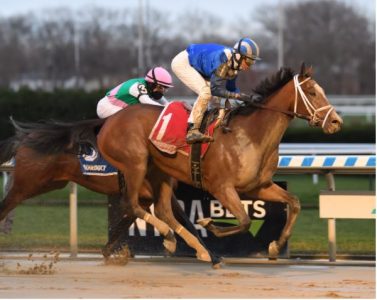By Ed McNamara
Trivia time: What do Go for Wand, Silverbulletday, and Shuvee have in common? All are in the Hall of Fame, won the Alabama Stakes and have major races named in their honor.
They’ve been running the Alabama at Saratoga since 1872, and so many great ones have won it. It’s a lot to ask Derby horses to run 1 1/4 miles on the first Saturday in May, and it’s a similar challenge for 3-year-old fillies in mid-August. The Alabama has been at 10 furlongs since 1917, and its final times in this century are reminders of how draining it can be. Most of the winners ran about two seconds slower than the colts did in the Travers.
The Alabama’s final furlong often is a desperate grind, but not last year. Swiss Skydiver was already 6 1/2 lengths clear at the eighth pole before Tyler Gaffalione geared her down in the final sixteenth, reducing her final margin to 3 1/2 lengths. The Preakness heroine could not have won more easily, and it’s unlikely that this generation of fillies will produce a match for her.

Malathaat – Photo Courtesy of NYRA
After Malathaat improved to 5-for-5 in the Kentucky Oaks, there was serious buzz that she might be the next filly superstar. Her reputation took a hit with a narrow loss at odds-on last month in Saratoga’s Coaching Club American Oaks. Maracuja, the 14-1 shot who beat her, will challenge her again on Saturday.
There were extenuating circumstances in the Coaching Club, in which Malathaat endured a brutal trip despite facing only three opponents. Maracuja and Clairiere ran relays at her and wore down the 3-10 favorite, per the Equibase chart footnotes: “Malathaat set the pace while hounded from the outside by Maracuja for the opening three-sixteenths, then by Clairiere from outside the five-eighths pole.”
Malathaat’s trainer, Todd Pletcher, said: “Hounded is an accurate description. She kind of had to fight off the whole field. When you’re a heavy favorite in a race like that with a short field, those things can happen. I’m not disappointed in the filly at all. I thought she ran bravely considering everything that was thrown at her off the layoff.”
Rob Atras, who trains Maracuja, knows that repeating in the rematch will be difficult.
“The way Malathaat had to run last time compromised her,” Atras said. “It won’t be an easy task to run against her again.”
Besides the Alabama, an excellent Spa card also features two grass stakes, the Grade 2 Lake Placid and the Smart N Fancy. Let’s see if we can make some money.
$120,000 Smart N Fancy Stakes, 5 1/2 furlongs, turf, fillies and mares 4 and up
Robin Sparkles (1), a need-to-lead type, looks like a standout at short odds to get her sixth grass win in eight tries. Besides having a pace advantage in a short field, she also has a class edge. She’s lost only twice in her last seven times, and the horses who beat her were multiple-stakes winners Caravel and She’s My Type. She’s a legitimate single in a pick 3 or the early pick 5.
$200,000 Lake Placid Stakes (G2), 1 1/16 miles, turf, 3-year-old fillies
Technical Analysis (2) looks like a good bet to repeat her convincing win in the Lake George on the meet’s second weekend. She’s been out of the money only once in five grass starts, and that was against Con Lima, a five-time stakes winner. Spanish Loveaffair (6) finished ahead of Con Lima (but was disqualified from first) at Gulfstream during the winter and is 0-for-3 since. She did run well two back when second in a Churchill Downs stakes and may be the best of the rest.
$600,000 Alabama Stakes (G1), 1 1/4 miles, 3-year-old fillies
Her trip in the Coaching Club American Oaks beat Malathaat (6), and Maracuja will be heavily bet to rebound. Her pedigree (by Curlin out of an A.P. Indy mare) says 10 furlongs will suit her fine. She has the speed to set the pace if John Velazquez wants to, but I expect he’d rather stalk in second or third. I see Clairiere (3), another daughter of Curlin, grinding up for second after Malathaat gets clear in midstretch. Settling for third will be Maracuja (4), who probably will be overbet off her upset last out.
Ed McNamara is an award-winning journalist who has been writing about thoroughbred racing for 35 years. He has handicapped races for ESPN.com, Newsday and The Record of New Jersey. He is the author of “Cajun Racing: From the Bush Tracks to the Triple Crown” and co-author of “The Most Glorious Crown,” a chronicle of the first 12 Triple Crown champions.



